
Intent Data 101: How to Find Prospects Actively Looking for Solutions Like Yours
- Last updated on: September 17, 2025
Timing is critical in today’s competitive B2B environment. The greatest struggle of Marketing and sales teams is not finding leads. But it is actually finding the right leads at the right time. Old prospecting is like shooting darts blindfolded, squandering resources and time on accounts that are not yet ready to buy. That’s where intent data becomes useful.
By knowing the signals your prospects are leaving behind while they do their research online, you can target active buyers looking for answers like yours and reach out to them before your competition does. In this piece, we’re going to discuss what it is, how to find these prospects, and why having a good partner like Intent Amplify® can assist you in making data into dollars.
What is Intent Data and Why It Matters
Purchase intent data monitors and measures online behavior to unveil moments when businesses are exhibiting purchase intent signs. These actions include browsing searches, downloads of content, social interactions, attendance at webinars, or visits to rival company sites.
By 2025, it will be a necessity for B2B sales and marketing, particularly in high-paced industries like fintech and cybersecurity. For instance, suppose one of the leading fintech players in the United States is openly searching for “fraud detection software.” If you can pick that activity early, your team can visit them with a customized solution. Before even issuing an RFP.
This method assists companies in focusing on high-value customers with genuine interest. Due to this, companies can reduce sales cycles by targeting prospects earlier. Growing revenue creation through synchronization of marketing and sales efforts is also more manageable. With 70% of buyers researching online before ever speaking with a vendor (Gartner), intent data is a valuable early win.
How to Identify Prospects Actively Searching for Solutions
It functions as a digital trail, uncovering where potential customers are along their buying process. Here’s how to spot and respond to it effectively:
1. Gather Signals from Multiple Sources
Begin by monitoring a combination of first-party data (from your website, CRM, and marketing automation platforms) and third-party data from reputable suppliers. Examples of important signals are visiting the pricing or product pages over and over again. Another one is downloading case studies or whitepapers about your solution. Reading about certain problem areas, like “embedded finance trends” or “cloud security best practices.”
2. Score and Prioritize Accounts
Not all clicks are created equal. Employ AI-based algorithms or scoring models to prioritize accounts by engagement depth and frequency. For example, a business that downloads three cybersecurity reports within a week is demonstrating much greater intent than one that looks at one blog post. This method guarantees your B2B sales teams concentrate on accounts with the highest chances of conversion.
3. Activate Through Content Syndication and ABM
Once you’ve identified high-intent prospects, acting fast is key. Content syndication ensures your brand’s resources. Like eBooks, reports, or webinars, reach these prospects wherever they are researching online. Account-Based Marketing (ABM) then helps your team personalize outreach with campaigns tailored to the specific company, industry, and buying stage. Pair these with omnichannel demand generation strategies to create consistent messaging across email, social, and paid ads. This integration fills the chasm between knowledge and action, converting intent data to pipeline growth.
Why Businesses Need an Ally Like Intent Amplify®
While intent data is potent, it is difficult for most companies to unlock its potential. Among the challenges facing them are data overload and systems not being integrated. And insufficient expertise in triggering insights to tangible outcomes. That is where Intent Amplify® comes in. Our experts are dedicated to assisting B2B technology, SaaS, fintech, and cybersecurity businesses to turn intent signals into revenue by:
- Streaming high-quality intent data from several trusted sources.
- Running content syndication campaigns that put your content squarely in front of active buyers.
- Building account-based marketing approaches customized to your most valuable opportunities.
- Driving omnichannel demand generation to guarantee consistent, data-driven interactions across every touchpoint.
With Intent Amplify®, you don’t just get data. You have a proven process to spot, prioritize, and convert buy-ready accounts, driving growth without investing resources into low-potential leads.
Conclusion
Intent data has revolutionized how B2B businesses do marketing and sales. By understanding prospects who are actively looking for solutions, you can engage buyers sooner, make their experience more personalized, and ultimately derive greater revenue.
The question is not if you should be using this. It is if you’re using it right. If you’re ready to unleash the maximum potential of intent marketing, Intent Amplify® can assist you in filling the gap between outcome and insights.
FAQs
1. How do I know if my business is ready to begin utilizing intent data?
If your sales team is having a tough time prioritizing leads or your marketing expenditures are high and low in ROI, it is time to make the best out of intent data.
2. What is the greatest challenge that businesses encounter when using intent data?
Most teams are gathering too much data without a plan or systems to effectively take action on it.
3. How soon can intent data enhance the quality of leads and conversions?
Results tend to be evident in the initial few campaigns when insights are combined with targeted outreach.
4. Do I require different tools for content syndication and ABM if I’m using intent data?
Not necessarily. The ideal partner can bring these together into one, streamlined solution.
5. How do I select the ideal partner to orchestrate my intent-driven campaigns?
Find a provider with established credentials, high-quality sources of data, and the capacity to convert signals into revenue, such as Intent Amplify®.



